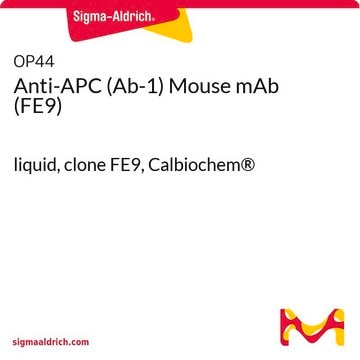MABC200
Anti-APC Antibody, clone CC-1
clone CC-1, from mouse
Sinonimo/i:
Adenomatous polyposis coli protein, APC, Deleted in polyposis 2.5
About This Item
Prodotti consigliati
Origine biologica
mouse
Livello qualitativo
Forma dell’anticorpo
purified immunoglobulin
Tipo di anticorpo
primary antibodies
Clone
CC-1, monoclonal
Reattività contro le specie
human
tecniche
immunohistochemistry: suitable
Isotipo
IgG2bκ
N° accesso NCBI
N° accesso UniProt
Condizioni di spedizione
wet ice
modifica post-traduzionali bersaglio
unmodified
Informazioni sul gene
human ... APC(324)
Descrizione generale
Immunogeno
Applicazioni
Immunohistochemistry Analysis: A representative lot from an independent laboratory detected APC in rat spinal cord injury tissue (McTique, D. M., et al. (2001). J Neurosci. 21(10):3392-3400.).
Qualità
Descrizione del bersaglio
Stato fisico
Not finding the right product?
Try our Motore di ricerca dei prodotti.
Codice della classe di stoccaggio
12 - Non Combustible Liquids
Classe di pericolosità dell'acqua (WGK)
WGK 1
Punto d’infiammabilità (°F)
Not applicable
Punto d’infiammabilità (°C)
Not applicable
Certificati d'analisi (COA)
Cerca il Certificati d'analisi (COA) digitando il numero di lotto/batch corrispondente. I numeri di lotto o di batch sono stampati sull'etichetta dei prodotti dopo la parola ‘Lotto’ o ‘Batch’.
Possiedi già questo prodotto?
I documenti relativi ai prodotti acquistati recentemente sono disponibili nell’Archivio dei documenti.
Il team dei nostri ricercatori vanta grande esperienza in tutte le aree della ricerca quali Life Science, scienza dei materiali, sintesi chimica, cromatografia, discipline analitiche, ecc..
Contatta l'Assistenza Tecnica.








